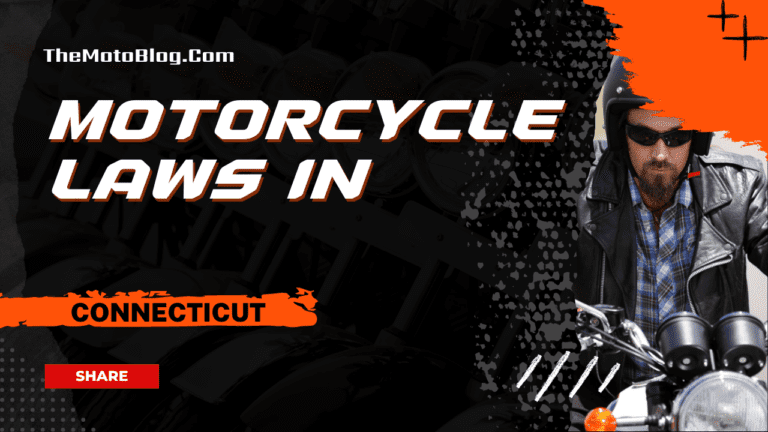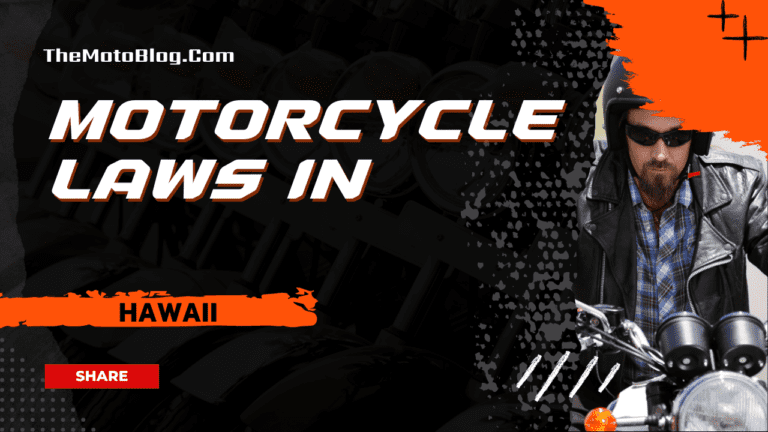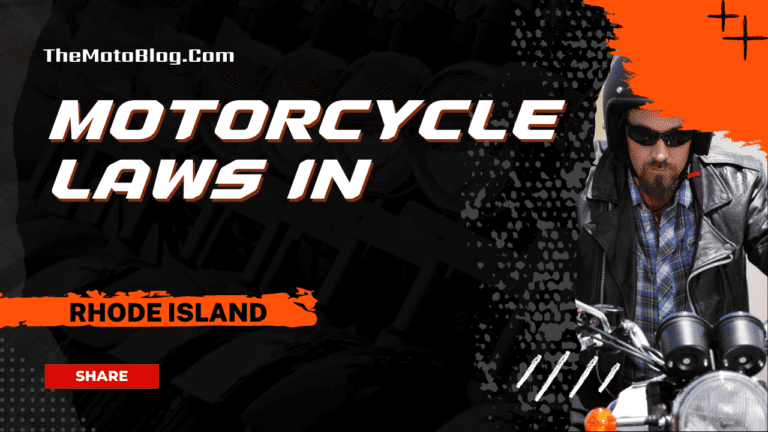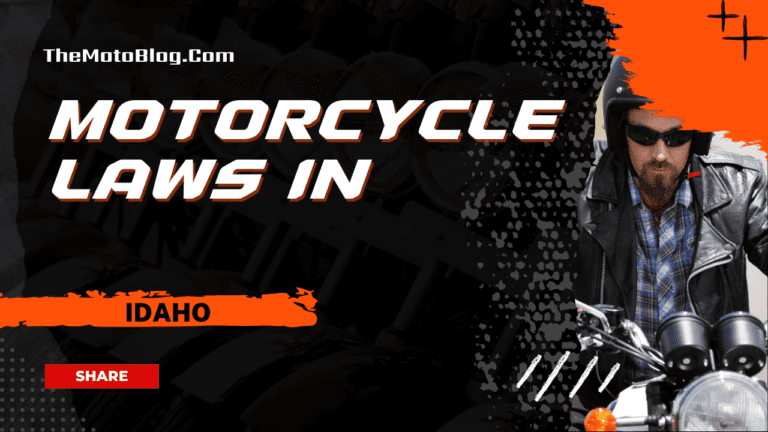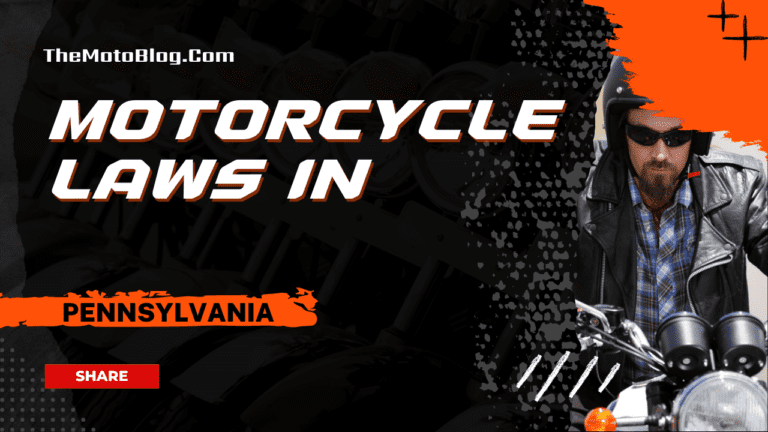Motorcycle Laws in Florida: What You Need to Know
If you’re planning to ride a motorcycle in Florida, it’s essential to understand the state’s motorcycle laws. These regulations, which can differ from those in other states, are in place to protect both motorcyclists and other road users, ensuring a safe and enjoyable riding experience. Being aware of Florida’s motorcycle laws will not only help you avoid potential fines, it’s also key to staying safe while cruising down the Sunshine State’s picturesque roads.
First and foremost, you’ll need a valid motorcycle license or endorsement. In Florida, individuals who are at least 16 years old can obtain a motorcycle-only license, while those who already hold a driver’s license will need a motorcycle endorsement. To achieve this, riders must pass a basic motorcycle rider course and a written exam. It’s particularly important to note that helmets are mandatory for riders under 21 years old and optional for riders 21 and older with at least $10,000 in medical insurance coverage.
Florida motorcycle laws also include specific headlights, turn signals, and lane sharing guidelines. Motorcycles must always have their headlights on, even during the day, and turn signals are required both in front and back of the bike. While lane splitting – the practice of riding between lanes of traffic – is illegal, it’s perfectly legal for two motorcyclists to ride side by side within the same lane. Remember these rules as you set out on your Florida motorcycle adventure, and you’ll be well on your way to a safe and enjoyable ride.
Understanding Florida’s Motorcycle Helmet Laws
Riding a motorcycle in Florida offers the thrilling feel of the open road combined with the beauty of the Sunshine State. But before you hit the streets, it’s important to understand the motorcycle helmet laws in Florida in order to ensure your safety and compliance with the law.
Florida’s motorcycle helmet law is governed by the Florida Statutes § 316.211 Equipment for motorcycle and moped riders. It’s imperative for all motorcyclists and their passengers to meet these legal requirements:
- Helmets: Riders over the age of 21 who carry a minimum medical insurance of $10,000 for motorcycle-related injuries are allowed to ride without a helmet. However, riders of all ages are highly recommended to wear approved helmets to reduce the risk of serious injury or death in an accident. Approved helmets have a DOT (Department of Transportation) sticker on the back, indicating compliance with federal safety standards.
- Eye protection: If your motorcycle doesn’t have a windshield, you’re required to wear eye protection like goggles or other protective eyewear to shield against road hazards and debris.
In addition, there are several rules and regulations specific to motorcycle operation in Florida:
- License and registration: You must have a Class “E” driver’s license or higher with a motorcycle endorsement to operate a motorcycle legally.
- Motorcycle riders course: If you’re under 21 years old, completion of the Basic Rider Course (BRC) is mandatory before obtaining a motorcycle endorsement or “Motorcycle Only” license.
- Insurance: Florida law requires motorcycle owners to carry Personal Injury Protection (PIP) insurance or demonstrate financial responsibility.
Here’s a summarized table of Florida’s motorcycle helmet laws:
| Age | Helmet Required | Insurance/Medical Coverage |
|---|---|---|
| Over 21 years | No | Minimum $10,000 |
| 21 years or younger | Yes | – |
By adhering to these regulations, you’ll be better prepared to ride safely and responsibly in Florida. Remember, your safety on the road is paramount, so even if helmet use isn’t legally required for you, please consider wearing one for added protection. Happy riding!
Motorcycle Insurance Requirements
Before you hit the road on your motorcycle in Florida, you must be aware of the insurance requirements. Ensuring you have proper coverage will not only protect you financially, but it will also help you abide by the law.
Florida’s motorcycle insurance requirements differ from those of cars because the state does not require motorcyclists to carry Personal Injury Protection (PIP) insurance. However, there are still crucial insurance requirements you should be aware of:
- Bodily Injury Liability (BIL) insurance: BIL covers the expenses for injuring others in an accident you cause. The minimum coverage levels required are:
- $10,000 per person
- $20,000 per accident
- Property Damage Liability (PDL) insurance: PDL covers the cost of damages to other people’s property in an accident that you cause. The minimum coverage required in Florida is:
- $10,000 per accident
It’s important to consider that these are the minimum requirements, and you may want to purchase additional coverage to ensure you are thoroughly protected. Other types of motorcycle insurance available include:
- Collision coverage: Protects your motorcycle in case of an accident involving a collision with another vehicle or object.
- Comprehensive coverage: Covers your motorcycle from damages due to theft, vandalism, or natural disasters.
- Uninsured/Underinsured Motorist coverage: Provides protection in case the at-fault party has no insurance or inadequate coverage.
Remember, Florida is a “no-fault” state, which means that regardless of who is at fault in an accident, each party’s own insurance will cover their expenses. Since motorcycles are exempt from the Personal Injury Protection requirement, riders may opt for medical payments coverage to help with medical expenses in case of an accident.
Keep in mind that if you choose not to carry the minimum required motorcycle insurance, you must be prepared to demonstrate “Financial Responsibility”. This means that you’ll need to show you can pay for damages and injuries resulting from a motorcycle accident. In Florida, an alternative method of showing financial responsibility is obtaining a “Certificate of Self-Insurance”. To qualify for this certificate, you must have a net unencumbered worth of at least $40,000.
Now that you’re aware of the motorcycle insurance requirements in Florida, you can make the best decision for your situation and ride with peace of mind knowing you’re protected and compliant with state laws.
Lane Sharing and Splitting Laws
When you’re riding a motorcycle in Florida, it’s important to know the rules of the road. One area of interest for many riders is the lane sharing and lane splitting laws. Here’s a breakdown of the key information you should be aware of as a motorcyclist in Florida.
Lane sharing, or riding alongside another motorcyclist, is permitted in Florida. However, there are a few restrictions you need to follow to stay safe and legal. Two motorcycles can ride side by side in the same lane, but you must remember to stick within the designated lane markings. Additionally, be cautious to only share a lane with another experienced and comfortable motorcyclist with this practice.
On the other hand, lane splitting, or riding between lanes of slow-moving or stopped traffic, is illegal in Florida. This practice is not considered safe and can lead to accidents and severe penalties. If you’re caught lane splitting in Florida, you could face fines and other serious consequences, such as points added to your driving record.
Here’s an overview of the differences between lane sharing and lane splitting in Florida:
| Topic | Description |
|---|---|
| Lane Sharing | * Permitted in Florida * Two motorcycles can ride side by side * Must stay within designated lane markings |
| Lane Splitting | * Illegal in Florida * Riding between lanes of traffic is not allowed * Can result in fines and penalties |
You should also be aware of Florida’s helmet laws. In Florida, riders under the age of 21 are required to wear a helmet, while those 21 and older can choose not to if they have at least $10,000 in medical insurance coverage. Remember that wearing a helmet is always a safer choice regardless of your age.
To ensure you’re riding safely, consider taking a motorcycle safety course approved by the Florida Department of Highway Safety and Motor Vehicles (FLHSMV). These courses will teach you the skills and knowledge needed to navigate Florida’s roads safely, and they may even qualify you for insurance discounts.
A few additional Florida motorcycle laws include:
- You must have a motorcycle endorsement on your driver’s license to operate a motorcycle.
- Daytime running lights are required for all motorcycles.
- Motorcyclists must follow Florida’s laws regarding turn signals, mirrors, and horns.
In summary, while lane sharing is allowed, it’s crucial to remember that lane splitting is illegal in Florida. Familiarize yourself with Florida’s motorcycle laws and always practice safe riding habits to protect yourself and other drivers on the road.
Motorcycle License and Endorsement
When you’re ready to hit the open road in Florida, it’s essential to understand the motorcycle licensing and endorsement requirements. The state of Florida issues Class E driver’s licenses, and to legally operate a two- or three-wheeled motorcycle, you must obtain a motorcycle endorsement on it.
Here are the steps to obtain your Florida motorcycle endorsement:
- Complete an approved Basic Rider Course (BRC) to learn essential riding skills and safety measures.
- Present the BRC completion certificate to your local DMV office.
- Pass a vision and written test if you don’t hold a Florida driver’s license. Note that written test requirements vary for license renewal or endorsement transfer from another state.
Florida also offers a Motorcycle Only License for those who don’t possess a Class E driver’s license yet. To obtain a Motorcycle Only License:
- Be at least 16 years old.
- Hold a learner’s license for a minimum of one year with no traffic convictions.
- Complete an approved BRC.
- Pass a vision and written test.
If you are under 18 years old, you must hold a learner’s license for 12 months or until your 18th birthday, whichever comes first, before moving onto a Motorcycle Only License or adding a motorcycle endorsement to your Class E license.
Florida motorcycle laws require helmet usage for riders under 21 years old or those without a minimum of $10,000 in medical insurance coverage. However, it’s advisable for all riders to wear helmets for their safety. Additionally, always wear eye protection when riding, which can be a shield, goggles, or glasses.
It’s crucial to register and insure your motorcycle to keep it street legal. Florida motorcycle registration laws are as follows:
- Annual renewal fees range between $13.50 and $18.00, depending on your motorcycle’s weight.
- At least $10,000 in personal injury protection (PIP) coverage is required, and a $30,000 combined single limit policy is also suggested.
- Motorcycles under 50cc don’t need to be registered in Florida, but riders must still have a valid Class E license or motorcycle endorsement to operate them.
Understanding and following Florida’s motorcycle license, endorsement, and insurance regulations’ll help maintain a safe and enjoyable riding experience for yourself and others on the road.
Required Safety Equipment in Florida
Florida has specific safety equipment requirements for motorcyclists to ensure they stay protected on the road. You’ll need to familiarize yourself with these requisites to remain within the law and ensure your utmost safety.
First and foremost, helmets come in as a vital piece of safety equipment. Riders aged 20 and below are required to wear helmets without exception. For riders aged 21 and above, wearing a helmet isn’t mandatory if they have at least $10,000 in medical insurance coverage. Nevertheless, wearing a helmet regardless of age is highly recommended since it significantly reduces the risk of head injuries.
You must also pay attention to eye protection. Florida law mandates that all riders wear eye protection, whether it’s goggles, glasses, or a protective face shield integrated into the helmet. This helps to shield your eyes from debris, insects, and weather conditions, allowing you to focus on the road.
When it comes to safety equipment for your motorcycle itself, there are regulations you need to respect as well. These include:
- A headlight that works both during daytime and nighttime
- At least one red taillight that can be seen from a minimum distance of 600 feet
- A horn capable of producing a sound that’s audible up to 200 feet away
Additionally, you should ensure these following requirements are met:
- Rear-view mirror: Florida law requires a motorcycle to have at least one mirror that clearly reflects a distance of 200 feet behind the rider. Having two mirrors is recommended, but not mandatory.
- Turn signals: While motorcycles built before 1972 aren’t required to have turn signals, those manufactured since must be equipped with turn signals. You should always use them to signal your intentions to other motorists.
- Brakes: Your motorcycle must be equipped with both front and rear brakes, allowing you to stop safely in a reasonable distance. Avoid bracing your feet against the road to maintain the vehicle stability.
- Finally, make sure you follow Florida’s laws on motorcycle exhaust systems. Cutting off or modifying your exhaust to make it louder isn’t permitted.
Motorcyclist Rights in Traffic
Navigating Florida’s roads as a motorcyclist means knowing your rights in traffic. Understanding these rights can help ensure a safe and enjoyable riding experience. Let’s dive into some key aspects of motorcyclist rights in Florida’s traffic.
Florida law requires all motorcyclists to follow the same rules and regulations as other motor vehicles. This means that you have the same rights and responsibilities as drivers in cars and trucks, such as:
- The right to use a full lane of traffic
- The responsibility to signal when turning or changing lanes
- The duty to obey traffic signals and signs
- The requirement to yield the right-of-way appropriately
However, Florida has specific laws designed to protect motorcyclists. For example, it’s illegal for vehicle drivers to:
- Cut off a motorcyclist or block their path
- Deliberately tailgate a motorcycle
- Throw objects or open car doors in a motorcycle’s path
Moreover, motorcyclists in Florida enjoy the following rights:
- Lane sharing: In some cases, two motorcyclists may share a lane, known as “lane splitting.” However, it’s important to note that lane splitting with a car is not permitted.
- Right to avoid hazardous conditions: If you need to make a sudden or necessary movement to avoid dangerous road conditions, such as debris, potholes, or puddles, you have the legal right to do so.
It’s essential to be aware of motorcycle-specific laws in Florida as well, such as:
- Helmet Laws: Riders under the age of 21 must wear a helmet while riding a motorcycle. Those 21 and older may ride without a helmet if they have insurance coverage of at least $10,000 for motorcycle-related injuries.
- Eye Protection: All riders must wear some form of eye protection, such as glasses, goggles, or a face shield.
Finally, here are some tips to help ensure a safe riding experience in Florida traffic:
- Be visible: Wear brightly-colored clothing and keep your headlight on at all times, even during daylight hours.
- Maintain a safe distance: Keep a proper following distance between you and the vehicle ahead of you, allowing for ample reaction time.
- Practice defensive riding: Be prepared for sudden movements or actions by other vehicles on the road.
So, next time you hit the roads in Florida, know your rights as a motorcyclist in traffic, and ride responsibly!
Violations and Penalties
So, you’re out riding in the Sunshine State and want to know what happens when motorcycle laws are broken? In Florida, traffic laws are enforced to ensure the safety of riders and motorists alike. It’s important to be aware of the potential penalties for violating motorcycle laws. Let’s break down some of the penalties you might face if you, unfortunately, get caught breaking the rules.
Speeding: Like all motorists, motorcyclists in Florida must follow posted speed limits. Fines for speeding are determined by how much over the speed limit the rider is:
| Speed Over Limit | Fine |
|---|---|
| 1 – 5 MPH | $25 |
| 6 – 9 MPH | $50 |
| 10 – 14 MPH | $100 |
| 15 – 19 MPH | $150 |
| 20 – 29 MPH | $250 |
*Please note, these fines are general estimates and can vary depending on the location of the violation.
Helmet Law Violations: Florida law requires that riders under the age of 21 wear helmets when operating a motorcycle. If you’re over 21 but don’t have the required insurance coverage, you’ll still need to wear a helmet. Violating the helmet law could lead to a $10 fine.
Impact on Insurance: Violations can affect the rates you pay for motorcycle insurance. This varies by violation – with major ones such as reckless driving or DUI causing larger rate increases.
Suspension or Revocation: Serious violations like DUI, excessive speeding, or accumulating too many points on your driving record can result in license suspension or revocation. In these situations, you might need to attend traffic school, complete a driver improvement course, or even serve jail time.
Violation Points: Florida uses a point system to track traffic violations on your driving record. Here’s a breakdown of points assigned for various infractions:
- Speeding (less than 15 MPH over the limit): 3 points
- Speeding (more than 15 MPH over the limit): 4 points
- Speeding that causes an accident: 6 points
- Riding without proper endorsement: 4 points
If you accumulate 12 or more points within 12 months, your license could be suspended for 30 days.
As a responsible motorcycle rider, it’s crucial to know and follow Florida’s motorcycle laws. Adherence to the rules of the road will not only keep you safe but also help you avoid hefty fines, insurance rate hikes, or even license suspension. Stay informed and enjoy your ride!
Motorcycle DUI Laws
Florida takes motorcycle DUI offenses seriously. If you’re caught riding under the influence, you can expect to face severe penalties. These penalties vary depending on the number of prior DUI convictions and other aggravating factors. Knowing the motorcycle DUI laws can help you stay on the right side of the law and avoid getting into legal trouble.
In Florida, you can be charged with a DUI if you’re operating a motorcycle with a Blood Alcohol Content (BAC) of 0.08% or higher. The BAC limit is lower for those under 21; it’s set at just 0.02%. It’s crucial to understand that you don’t have to be visibly impaired to be charged with a DUI. Simply having a BAC over the legal limit can result in severe consequences.
The penalties for a first-time DUI conviction in Florida on a motorcycle include:
- Fines ranging from $500 to $1,000
- Up to 6 months in jail
- A mandatory driver’s license suspension of at least 180 days
- A DUI Program or substance abuse treatment, as required by the court
If you’re convicted of a second DUI offense, the penalties increase significantly:
- Fines ranging from $1,000 to $2,000
- Up to 9 months in jail
- A mandatory driver’s license suspension of at least 5 years
- An Ignition Interlock Device installed on all vehicles, including motorcycles, for at least 1 year
For a third DUI conviction within 10 years, the penalties become even more severe:
- Fines ranging from $2,000 to $5,000
- Up to 12 months in jail
- A mandatory driver’s license suspension of at least 10 years
- An Ignition Interlock Device installed on all vehicles, including motorcycles, for at least 2 years
Here are a few important points to remember about motorcycle DUI laws in Florida:
- Helmets aren’t required in Florida if you’re over 21 and have at least $10,000 in medical insurance coverage. However, it’s safer to wear a helmet while riding a motorcycle, especially if you’ve been drinking.
- A DUI conviction can affect your motorcycle insurance rates. Your premiums may increase significantly, making it more expensive to maintain your coverage.
- Refusing a breathalyzer test can result in an automatic driver’s license suspension. In Florida, by operating a motorcycle, you’ve given implied consent to submit to a breath, blood, or urine test if law enforcement suspects DUI.
Understanding Florida’s motorcycle DUI laws allows you to make informed decisions and avoid serious consequences. Always ride responsibly, and if you’ve been drinking, arrange for a safe way home.
Monthly Motorcycle Safety Tips
Keeping safety top of mind is crucial for motorcyclists in Florida. This section will offer monthly safety tips to help you enjoy your rides while staying protected on the road. By following these guidelines, you can reduce the risks associated with motorcycle riding and ensure a pleasurable experience.
Always wear protective gear: The use of helmets and other safety equipment can significantly reduce the severity of injuries. Remember, Florida law requires riders under 21 to wear helmets, and all riders must carry at least $10,000 in medical benefits for injuries incurred while riding.
- Invest in a high-quality helmet
- Wear protective clothing like jackets, gloves, and boots
- Consider installing a windshield or wearing a face shield
Stay visible to other drivers: Since motorcycles are smaller than cars, they can be less noticeable on the road.
- Use your headlights day and night
- Wear brightly colored clothing
- Practice using turn signals and hand signals
Routinely check your motorcycle: Perform regular maintenance checks to ensure your bike is in excellent working condition.
- Monitor tire pressure and tread
- Inspect your brakes, lights, and mirrors
- Check fluid levels and replace when necessary
Stay informed about Florida’s motorcycle laws: By understanding and adhering to the rules and regulations, you can avoid fines and penalties.
- Familiarize yourself with traffic laws and speed limits
- Know the requirements for motorcycle endorsements on your license
- Be prepared for any new legislation affecting motorcycle riders
Enhance your skills: Even experienced riders can benefit from ongoing training to sharpen skills and bolster confidence.
- Attend motorcycle safety courses
- Brush up on your defensive riding techniques
- Share best practices with fellow riders
Remember to observe proper lane positioning and maintain a safe following distance from other vehicles. Also, be on the lookout for changing weather conditions in Florida, as they can significantly impact your ride. Stay proactive and receptive to feedback from fellow riders to continually improve your motorcycle safety habits. By keeping these monthly safety tips in mind, you’ll contribute to a safer riding environment for yourself and others on the road.
Conclusion: Riding Responsibly in Florida
Florida’s beautiful weather and scenic routes make it a popular destination for motorcycle enthusiasts. However, it’s crucial for riders to familiarize themselves with the state’s motorcycle laws to ensure a safe and enjoyable experience.
Remembering a few key aspects of Florida’s motorcycle laws can make a world of difference:
- Helmets: Riders over 21, with a minimum of $10,000 in medical insurance coverage, can choose not to wear a helmet.
- Eyewear: Protective eyewear must be worn by all riders, regardless of helmet use.
- Gear: Reflective vests or clothing are not required, but it’s wise to wear them for better visibility.
Additionally, make sure you know the requirements for motorcycle licenses, insurance, and registration:
- Florida has a tiered licensing system. Depending on the type of motorcycle, you’ll need a Class E license, Motorcycle Only license, or Motorcycle Endorsement.
- It’s essential to carry the minimum insurance requirements for property damage liability and personal injury protection.
- The registration process will depend on your motorcycle’s specifications.
Aside from the legal aspects, there are a few common-sense practices all motorcycle riders should follow:
- Maintain a safe distance between other vehicles and motorcycles.
- Use appropriate signals when turning or changing lanes.
- Keep your motorcycle in good working condition.
- Stay vigilant and focused on the road.
By keeping these points in mind, you’ll contribute to a safer environment for yourself and fellow riders. Enjoy the thrill of the open road and Florida’s breathtaking sights – just remember to stay responsible and follow the law.
Motorcycle Laws in the US By States
If you liked this article, then please subscribe to our YouTube Channel for more Bike Videos. You can also find us on Instagram, Twitter and Facebook.
Disclosure: As an Amazon Associate, I earn from qualifying purchases. Read more about Amazon Affiliate Disclaimer.

Vishwanath Mathpati
I am Vishwanath Mathpati, a full-time Blogger and Motorcyclist from Bidar, Karnataka. I love writing about my Motorcycles Stories and Riding Gears on this blog.
Know More About Me.

